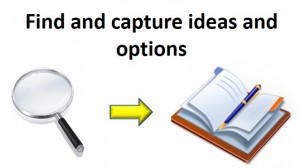Situation
Carol, a Section manager in a policy focused government department, had been tracking ‘design thinking’ for about 18 months. She had become more and more convinced that it could help with the more intractable policy issues that her Section had to address. Design thinking seemed to offer a way to identify and explore novel, yet practical, policy options.
As most of the examples of design thinking that Carol had read or heard about were focused on tangible products and services, she was not sure about the best way to introduce it into her ‘battle hardened’ group of pragmatic policy professionals. Her main concern was that the people in her group were excellent analysts. Once they were presented with a situation, they were good at uncovering existing data and analyzing every aspect of it. But they had limited experience of identifying more creative options and exploring how they might evolve in complex situations.
 Carol was wary of taking a programmatic approach to introducing design thinking. She recognized that introducing design thinking was itself typical of the type of problems that she was looking for design thinking to address – problems that are complex and evolving and for which there is no one right answer. Carol understood that she needed to start to ‘prime’ the key staff in her section to see situations from a more options based perspective and that this would require significant growth of their awareness of the options available to them. Carol also recognized that many novel ideas come from combining similar-but-different perspectives and that the priming would need to include exposure to similar-but-different situations and contexts.
Carol was wary of taking a programmatic approach to introducing design thinking. She recognized that introducing design thinking was itself typical of the type of problems that she was looking for design thinking to address – problems that are complex and evolving and for which there is no one right answer. Carol understood that she needed to start to ‘prime’ the key staff in her section to see situations from a more options based perspective and that this would require significant growth of their awareness of the options available to them. Carol also recognized that many novel ideas come from combining similar-but-different perspectives and that the priming would need to include exposure to similar-but-different situations and contexts.
Carol held a meeting with all the staff in her Section to tell them that she was keen to explore how design thinking might apply to their work, especially the more complex policy questions and issues. Carol indicated that she did not know exactly how and where it would apply and asked the staff to join her on the journey in a spirit of curiosity and tolerance. Carol had built considerable credibility and trust with her staff and, even though many of them associated ‘design’ with creativity and aesthetics not the pragmatic and hard-nosed issues of policy, they were prepared to give Carol the benefit of the doubt. They trusted that she was not just pursuing a fad and that she would not put the Section’s hard-won reputation at risk.
First, Carol identified a range of similar-but-different groups that could be sources of broader options, ideas and perspectives. These included
- University groups that take a more research based perspective to the types of issues her section addresses
- Engineering consultancies that undertake related feasibility studies and manage the projects that often arise from their policies
- Similar policy groups in countries whose context is similar but not exactly the same
- Stakeholders and interest groups that are affected by their policies but do not usually have much influence
- Conferences that are related to their policy area but are broader in scope than those her staff usually attend.
Carol then arranged a series of open-ended visits, discussions and seminars with these groups. The purpose was not focused on any particular issue or policy, but rather on exploring similarities and differences and identifying any interesting or novel approaches, ideas or perspectives. The attendees from her Section were asked to take comprehensive notes that were then uploaded to Section’s intranet site. Carol read all such notes soon after they were loaded and identified any content that she thought should be highlighted to others in the group and would benefit from wider discussion, which she then arranged. Those attending these events soon realized that Carol took an active interest in them and the quality of the related notes. Wherever appropriate, Carol also started to refer to ideas and options in the notes during the Section’s day-to-day policy work. Progressively, the intranet content became a valuable resource for stimulating alternative perspectives, ideas and options.





Follow Us!